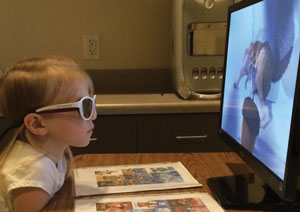Effective treatments for common children’s conditions often fall short of their full potential because they are too tedious for the pediatric cohort. Researchers from McGill University, Southwestern Medical Center and the Retina Foundation of the Southwest may have surmounted this hurdle when it comes to treating amblyopia with contrast-balanced dichoptic therapy.
 | |
| Binocular vision brings together the parts of the movie shown separately to the ambyopic and fellow eye. |
Their study, published in the Journal of the American Association for Pediatric Ophthalmology and Strabismus, found that modifying popular children’s movies for dichoptic presentation significantly improved visual acuity. “Children achieved one to four lines of improvement in visual acuity with just six sessions, or nine hours of movie viewing over two weeks,” explains Eileen Birch, PhD, co-author.
Eight children between the ages of four and 10 viewed dichoptic movies of their choice, out of a selection of 18, three times per week over 14 days. According to the study, an image mask containing a pattern of irregular shapes was multiplied with the movie images seen by the amblyopic eye. An inverse mask was multiplied with the images seen by the non-amblyopic eye. Contrast was reduced enough to allow binocular vision and then increased by 10% at each visit. Best-corrected visual acuity, random dot stereoacuity and suppression were measured at the onset and after fourteen days.
“This certainly has the potential to change the way we treat amblyopia,” says Erin Jenewein, OD, MS, assistant professor at Nova Southeastern University’s College of Optometry. “I think the main issue right now is that there is no large randomized controlled trial to show whether or not this method is as good as patching.”
The authors hope that controlled studies can confirm their findings and make passive viewing of dichoptic movies a valid therapeutic modality for amblyopia—one that is far more child-friendly.
Li SL, Reynaud A, Hess RF, et al. Dichoptic movie viewing treats childhood amblyopia. JAAPOS. 2015 Aug;19(5):401-5.
